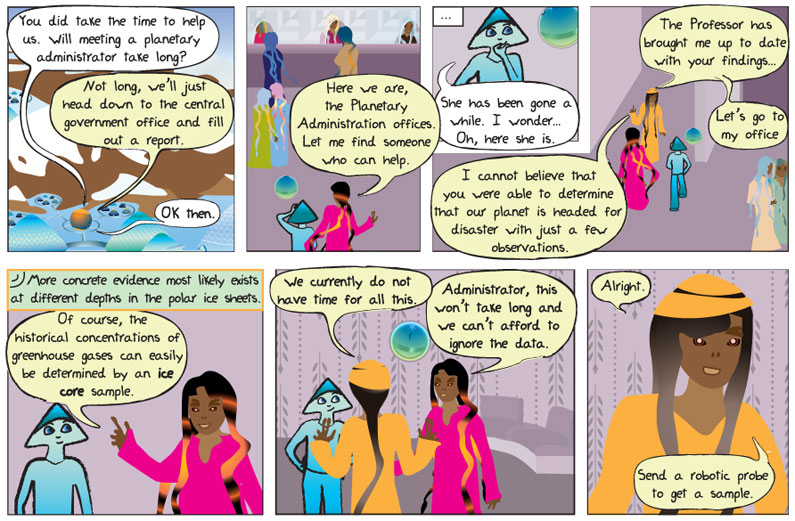
Comic Transcript
Panel 1.
Alkina: You did take the time to help us. Will meeting a planetary administrator take long?
Professor 2: Not long, we’ll just head down to the central government office and fill out a report.
Alkina: OK then.
Panel 2.
[A little while later.]
Professor 2: Here we are, the Planetary Administration offices. Let me find someone who can help.
Panel 3.
Alkina: She has been gone a while. I wonder… Oh, here she is.
Administrator: The Professor has brought me up to date with your findings… Let’s go to my office.
Panel 4.
Administrator: I cannot believe that you were able to determine that our planet is headed for disaster with just a few observations.
Panel 5.
Epo: More concrete evidence most likely exists at different depths in the polar ice sheets.
Professor 2: Of course, the historical concentrations of greenhouse gases can easily be determined by an ice core sample.
Panel 6.
Administrator: We currently do not have time for all this.
Professor 2: Administrator, this won’t take long and we can’t afford to ignore the data.
Panel 7.
[The administrator thinks for a moment.]
Administrator: Alright. Send a robotic probe to get a sample.
What does it mean?
Ice core – is a cylindrical section of ice retrieved from snow packs or glaciers that have formed over several hundreds or thousands of years.
Is that all?
Exploring Paleoclimatology using Vostok Ice Core Data – Classroom activity using real ice core data that teaches students about historical climate change, ice ages and glacial cycles, and more.
Deep ice tells long climate story – A news article about how current levels of carbon dioxide in our atmosphere compares to the past.
West Antarctic Ice Sheet (WAIS) – This page contains an excellent video by scientists studying ice core samples about what ice cores can tell us about Earth’s past, and what we can predict for the future based on what we know about the past.
Cross section image of ice core sample.

Credit: British Antarctic Survey
